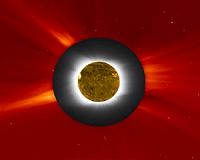 |
Science@NASA Huntsville AL (SPX) Dec 20, 2010 Everyone knows that "the moon on the breast of new-fallen snow gives the luster of mid-day to objects below." That is, except during a lunar eclipse. The luster will be a bit "off" on Dec. 21st, the first day of northern winter, when the full Moon passes almost dead-center through Earth's shadow. For 72 minutes of eerie totality, an amber light will play across the snows of North America, throwing landscapes into an unusual state of ruddy shadow. The eclipse begins on Tuesday morning, Dec. 21st, at 1:33 am EST (Monday, Dec. 20th, at 10:33 pm PST). At that time, Earth's shadow will appear as a dark-red bite at the edge of the lunar disk. It takes about an hour for the "bite" to expand and swallow the entire Moon. Totality commences at 02:41 am EST (11:41 pm PST) and lasts for 72 minutes. If you're planning to dash out for only one quick look -- it is December, after all -- choose this moment: 03:17 am EST (17 minutes past midnight PST). That's when the Moon will be in deepest shadow, displaying the most fantastic shades of coppery red.
Why red? You might expect Earth seen in this way to be utterly dark, but it's not. The rim of the planet is on fire! As you scan your eye around Earth's circumference, you're seeing every sunrise and every sunset in the world, all of them, all at once. This incredible light beams into the heart of Earth's shadow, filling it with a coppery glow and transforming the Moon into a great red orb. Back on Earth, the shadowed Moon paints newly fallen snow with unfamiliar colors--not much luster, but lots of beauty. Enjoy the show.
Share This Article With Planet Earth
Related Links Animated map of the Solstice Lunar Eclipse Solar and Lunar Eclipses at Skynightly
 Composite Image Of 2010 Eclipse
Composite Image Of 2010 EclipseWashington DC (SPX) Jul 16, 2010 A solar eclipse photo (gray and white) from the Williams College Expedition to Easter Island in the South Pacific (July 11, 2010) was embedded with an image of the Sun's outer corona taken by the Large Angle Spectrometric Coronagraph (LASCO) on the SOHO spacecraft and shown in red false color. LASCO uses a disk to blot out the bright sun and the inner corona so that the faint outer corona ... read more |
|
| The content herein, unless otherwise known to be public domain, are Copyright 1995-2010 - SpaceDaily. AFP and UPI Wire Stories are copyright Agence France-Presse and United Press International. ESA Portal Reports are copyright European Space Agency. All NASA sourced material is public domain. Additional copyrights may apply in whole or part to other bona fide parties. Advertising does not imply endorsement,agreement or approval of any opinions, statements or information provided by SpaceDaily on any Web page published or hosted by SpaceDaily. Privacy Statement |